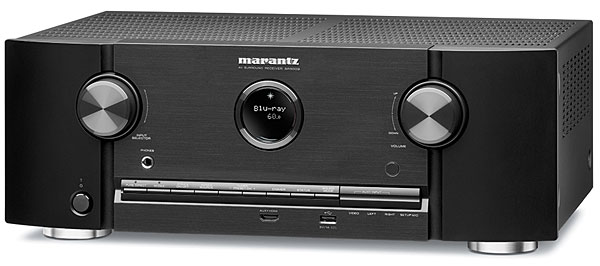Marantz SR5009 AV Receiver Review Page 2
 D=M?
D=M?
I sometimes break in receivers before running their room correction systems and try not to reach any hasty conclusions. But I couldn’t help noticing after a few hours that this Marantz, au naturel, seemed strikingly similar to the last few Denon receivers I’ve reviewed. That meant a reticent top end, quite unlike Marantz models I’ve known in the past. Is D+M adopting similar voicing for both lines (or homogenizing the critical innards)? Denon says no—that Denon and Marantz products are voiced and sound-tuned by two wholly separate teams, and that the SR5009 also has additional preamp circuitry (their HDAMS module) not found in Denon models.
But both brands not only sounded the same unvarnished but also reacted similarly to room correction. With Audyssey MultEQ XT in play, the room-corrected difference was startling, with remarkable gains in detail, the imaging of objects in the soundfield, and overall soundfield integrity. As I did with the last Denon receiver I reviewed, I preferred MultEQ’s slightly rolled-off Reference setting for movies and the livelier Flat setting for music. Folks, I’m not complaining: This receiver sounded beautiful. Whatever D+M is aiming to do, it’s working.
Homefront, with a proficient Sylvester Stallone screenplay, continues a recent uptick in the quality of soundtracks for Jason Statham action movies. If you like your motorcycles, DEA raids, shootouts, explosions, and other assorted apocalypses well integrated with clear dialogue, you’d like the way the Marantz handled this soundtrack. Audyssey’s bass equalization was spot on, shaping bass above and below the sub crossover to a fare-thee-well, and seamlessly integrating the speakers and sub. One benefit of licensing Audyssey is the option of the Dynamic EQ and Dynamic Volume low-level listening modes. As afternoon turned to evening, a time of day when I like to quiet down, I invoked both modes for the movie’s final half-hour, with Dynamic Volume at its lightest setting. It allowed me to adjust the volume control downward slightly.
Captain Phillips has Tom Hanks at the helm of a merchant ship, squaring off against Somalian pirates. The Marantz continued to effortlessly handle diverse soundtrack elements—tense dialogue, seafaring sounds, all the things that make you feel you’re aboard a ship—and louder passages showed no sign of strain. This demo lingered even later into the evening’s quiet time. As the thunderous quasi-military finale got underway, I turned Dynamic EQ/Volume back on, this time at the medium setting. This enabled an even lower volume setting, yet the soundtrack elements were so well juggled that the almost unbearable tension never abated.
After all those action thrills, the broad comedy of The Grand Budapest Hotel came as a relief. It has one of the most whimsical musical scores I’ve heard in a long time, which the Marantz delivered lovingly—not for the first time, I ascribe human characteristics to hardware—with loads of textural and spatial richness. Balalaikas festooned the soundtrack, and by the time the credits rolled, they had taken over completely, with the Ludmila Zykina State Academic Russian National Balalaika Ensemble executing mad dervishes all over the place.
Black Cow, White Vinyl
I recently added a Masterdisk pressing of Steely Dan’s Aja to my library. (Regrettably, I can’t afford the Cisco pressing that many rave about.) With or without room correction, this best-case content sounded great. I admired the amp’s warm voicing, and it gave the drum kit the meaty weight it deserved, especially (of course) on “Black Cow.” But as much as I liked the amp’s intrinsic sound, the addition of Audyssey MultEQ XT’s Flat setting solidified the imaging, opened up the soundstage, and made every instrument pop—all of which better suited the epic title track, with its warm synths, serpentine guitar solos, and climactic drum solo.
In anticipation of the vinyl box set of The Beatles in Mono, I dusted off my late-1960s Parlophone mono pressing of Rubber Soul. (A large but inaudible scratch on side one had brought it down to a price I could afford.) Combined with the newly installed Denon preamp, the Marantz receiver brought me closer to the music than ever. As well as it worked with Audyssey on, it cohered even more with Audyssey off; Marantz’s amp was born to beatify the Beatles. As an extended encore, I played my late-1970s French white-vinyl copy of The Beatles (a.k.a. The White Album). Despite its inherently brighter tonal balance, it sounded more luscious with Audyssey off. My respect for the Marantz’s intrinsic qualities as an amp continued to grow.

The Marantz showed off its rhythmic virtuosity and tonal richness in John Cage’s Complete Music for Prepared Piano, a three-CD set from Giancarlo Simonacci. The pianist faithfully reproduces Cage’s manipulation of the piano with nuts, bolts, nails, wood screws, pennies, bamboo strips, and weather stripping placed on, between, or under the stretched metal strings. So many of these sounds have been synthesized and tossed into movie soundtracks that they now seem comfortingly familiar.
A less than adequate system might lead you to believe that the sounds on these CDs are in fact synthesized. But it takes great speakers, like my Paradigms, and a solid amp to make them sound realistic and somehow that much stranger. The Audyssey room correction was a great help, bringing out the weird textures of the tortured piano strings. Turning off the room correction deprived them of their incredible complexity and beauty.
The Marantz SR5009 is a solidly engineered surround receiver with an inherently good-sounding amp and the kind of room correction that takes the amp to the next level. The multiple presences of Wi-Fi, AirPlay, and Bluetooth are necessary concessions to the way people listen now, though this receiver also accommodates old-fashioned disc-spinning listeners with the kind of performance that makes a hard-copy music library worthwhile. Once, I came this close to adopting a somewhat beefier Marantz as my reference receiver. The brand’s reputation for delivering great sound continues to be well earned.





























































